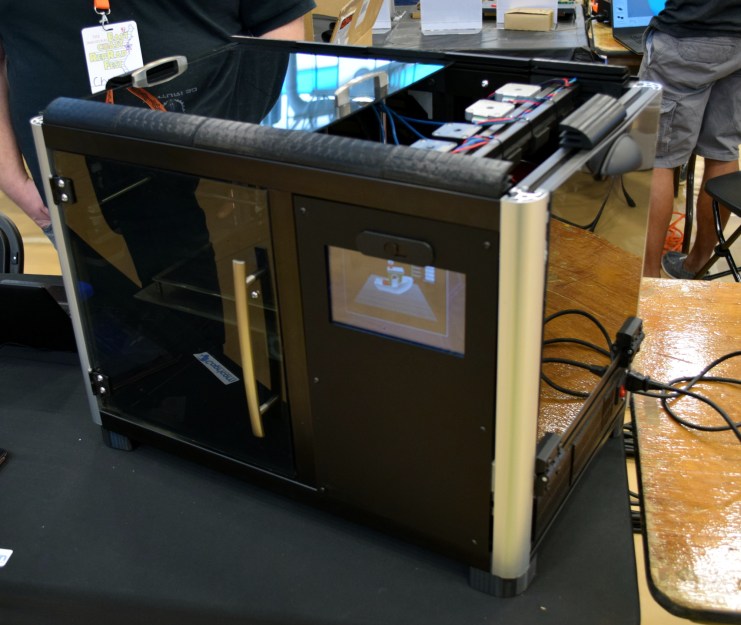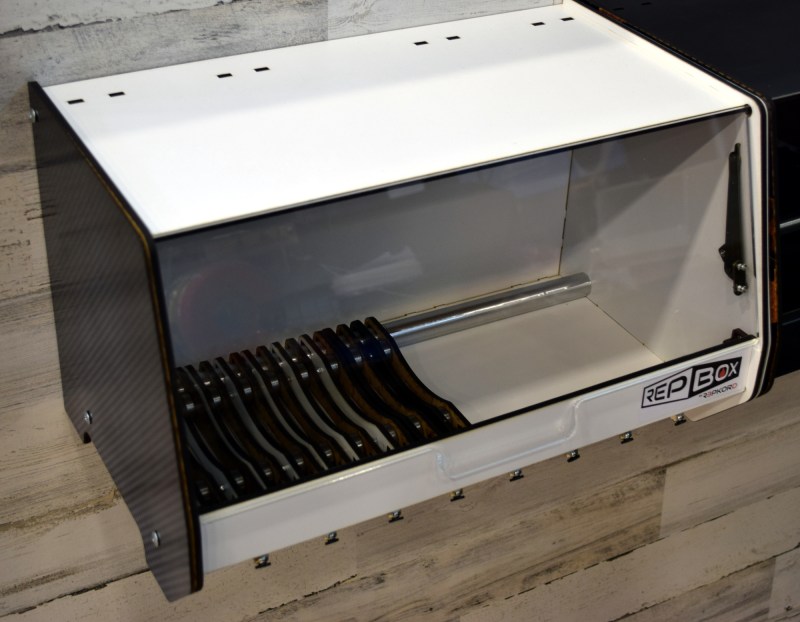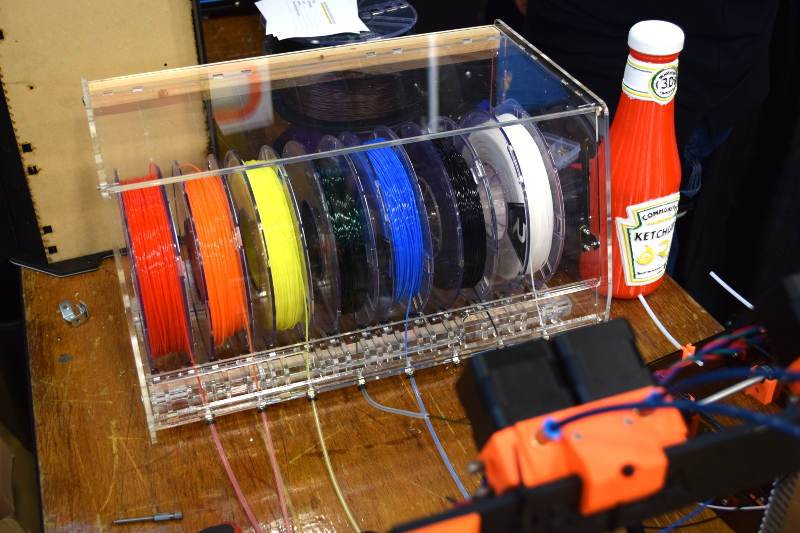While ostensibly the purpose of the recent East Coast RepRap Festival (ERRF) was to celebrate the 3D printing community and culture, it should come as no surprise that more than a few companies decided to use the event as an opportunity to publicly launch new products. Who can blame them? It’s not as if every day you have a captive audience of 3D printing aficionados; you might as well make the best of it.
Many creations were being shown off for the first time at ERRF, and we surely didn’t get a chance to see them all. There was simply too much going on at any given time to be sure no printed stone was left unturned. But the following printers, filaments, and accessories caught our attention long enough to warrant sharing with the good readers of Hackaday.
Keep in mind that much of this information is tentative at best, and things could easily change between now and when the products actually go on sale. These events serve as much as a sounding board for new products as they do a venue for advertising and selling them, so feedback received from show attendees may very well alter some of these products from what we saw at ERRF.
Venturi 3D
 Out of all the 3D printers on display at ERRF, the Venturi 3D still managed to stand out. While so many other companies are putting out vaguely Prusa i3 inspired designs, the Venturi looks more like a modern “smart” refrigerator. Whether or not that is an improvement is up to the individual, but it certainly looks very professional.
Out of all the 3D printers on display at ERRF, the Venturi 3D still managed to stand out. While so many other companies are putting out vaguely Prusa i3 inspired designs, the Venturi looks more like a modern “smart” refrigerator. Whether or not that is an improvement is up to the individual, but it certainly looks very professional.
A fully enclosed machine is still somewhat rare in the desktop 3D printer market, but creator Chris Lane has gone one better and brought the filament inside the enclosure as well. Not just one roll either, but four; as the Venturi just so happens to be multi color/material capable. In theory, bringing the filament inside the enclosure solves the issue of how you keep in-use filament dry. But the lack of any obvious seals around the multiple doors on the Venturi does make us skeptical that the interior humidity of the machine would ever be much different from ambient.
The quad Bowden extruders feed a E3D V6 hotend via low-friction Capricorn XS PTFE tubing, and the CoreXY motion is provided by a DuetWifi controller. An Android tablet running custom software provides the front panel interface, and comes pre-loaded with 1,000+ 3D models which the user can select from multiple categories. These models have been sliced specifically for the Venturi, and are there to give the user a baseline library of known good prints.
An earlier prototype of the Venturi 3D printer was on display at MRRF, but according to Chris, the build demoed at ERRF was the final version which is slated to go on sale later this summer for $1,299.
Printrbot Easy
 In a somewhat surprising move, Printrbot CEO Brook Drumm used ERRF as an opportunity to present a potential new product which he’s calling the “Easy”. Realizing that a race to the bottom against overseas manufacturers is simply not possible for a small American company, the team at Printrbot are instead looking at the possibility of modifying and branding an imported printer.
In a somewhat surprising move, Printrbot CEO Brook Drumm used ERRF as an opportunity to present a potential new product which he’s calling the “Easy”. Realizing that a race to the bottom against overseas manufacturers is simply not possible for a small American company, the team at Printrbot are instead looking at the possibility of modifying and branding an imported printer.
Printrbot has long been a champion of both open source and local manufacturing, so seeing what’s clearly a FlashForge Finder with Printrbot logos on it left some attendees scratching their heads. But Brook assured anyone who asked that the traditional Printrbot way of doing things isn’t going away. Selling a branded printer simply allows them to maintain a presence in the entry-level printer market while focusing their R&D on bigger and better things. Indeed, right next to the Printrbot Easy was the latest version of the Printrbelt, a truly unique printer that had no parallel at ERRF.
Brook says he hasn’t fully committed to releasing the Printrbot Easy, and will be using feedback from ERRF to help make the final decision. If the product does go live, expect a sub-$400 price tag and the same support and warranty Printrbot offers on their in-house machines.
Budmen Buildini
 Budmen Industries is best known for their large-scale functional prints, from chairs to lampshades. These have been printed in-house with a large printer of their own design, and the lessons they’ve learned from that machine have inspired them to release a commercial printer for other creators and artists who want to go big.
Budmen Industries is best known for their large-scale functional prints, from chairs to lampshades. These have been printed in-house with a large printer of their own design, and the lessons they’ve learned from that machine have inspired them to release a commercial printer for other creators and artists who want to go big.
With a 500x300x490mm build area the Buildini offers plenty of room to grow, and the Titan Aero combination extruder/hotend will certainly be able to lay down the filament. Some might be surprised by the lack of a heated bed, but without an enclosure it’s unlikely you’d be able to keep large ABS prints from warping anyway. Low-warp materials like PLA and PETG will be order of the day.
The design of the Buildini looks both robust and exceptionally simple. The design does away with separate linear rails or smooth rods, and instead moves the entire extruded aluminum frame. It’s an interesting approach, and offers a fantastically low part-count considering how large the printer is.
The Buildini will be manufactured at Budmen Industries headquarters in Philadelphia, and will start shipping in September for $2,300.
RepKord RepBox
 Aiming to provide a little higher class air-tight storage for your rolls of filament than the plastic tote most of us are using currently, Repkord has created the RepBox. This wall mounted filament storage system gives you a way to keep filament dry and ready for immediate use. The RepBox is made of steel and MDF, but a clear acrylic version of the box that was on display ended up being such a hit that it’s now available as an option.
Aiming to provide a little higher class air-tight storage for your rolls of filament than the plastic tote most of us are using currently, Repkord has created the RepBox. This wall mounted filament storage system gives you a way to keep filament dry and ready for immediate use. The RepBox is made of steel and MDF, but a clear acrylic version of the box that was on display ended up being such a hit that it’s now available as an option.
Thanks to internal rollers and standard pneumatic fittings, up to eight rolls of filament can be used simultaneously without exposing them to the ambient air. If you’ve got a wall of 3D printers in your shop, or you’re running a multi material/color setup, this would be an excellent way to centralize your filament supply.
The standard kit is available on the RepKord site for $89.99, and the clear version will set you back $139.99.
Tangerine Orange Metallic (TOM)
During his recent tour of the US, Thomas Sandlanderer teamed up with Proto-Pasta to come up with his own automotive-inspired color of HTPLA. A beautiful orange with an infusion of silver glitter, the color was so popular that Proto-Pasta decided to add it to the official lineup and sell it for the first time ever at ERRF. It’s now available on their website at $29.99 for a 500g spool.
An Impressive Start
Considering this was the first time the East Coast RepRap Festival was held, an impressive number of products were unveiled during the two days of the show. These manufacturers had enough faith in the 3D printing community to come out and support an untested venue that they were willing to hinge their launch on it. Judging by the number of attendees, we’d say the gamble paid off and can’t wait to see what next year brings.


















Does $2,300 printer with 3 alu extrusions also comes with 10 pounds/kg gold flakes filament?
It does come with a 40×4 character display from 1990, so you pay extra for vintage!
The extrusion, wheels and pretty much whole motion just looks like “OpenBuild” parts, common in CNC routers.
Looks like an ill designed machine. With a bed that large, any material will fail at the full print size. Even PLA.
The large bed can be useful to print multiples. I agree that a big print using the whole bed will be challenging to say the least…
Yeah no kidding, that’s insanely overpriced
Printrbot is still relevant?
Hello, I’m the creator of the Venturi 3D Printer. The ERRF prototype was around 90% completed. We now have the enclosure all the way around the top of the printer and will be investigating ways to further keep out moisture as well.